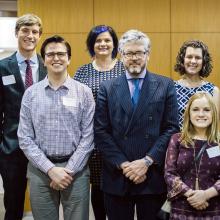
Sitting at a work station in Swem Library’s digital lab, Connor Fenton ’17 combs through a digital copy of a 17th century royal diary. Written by Queen Charlotte, the diary contains recordings of the baths her husband, King George III, has taken.
“I thought it was very interesting that she recorded these baths because she didn’t just mention that he had a bath, she documented how many baths and what time of day each occurred. It seemed odd that she was so preoccupied with his hygiene,” Fenton said.
It wasn’t until he saw the new BBC documentary, George III – The Genius of the Mad King, that he learned that the “baths” were not strictly for cleanliness, but considered a form of therapy for King George III’s mental issues.
“The documentary suggested that the baths were therapeutic, and that’s definitely one of the possibilities that make the most sense. I’m no expert on bathing culture, but it seems to be the implication she was going for, that the baths were for his health. That’s the beauty of history, that it is open to interpretation,” said Fenton.
These are the types of surprises that can be found in the treasure trove that is the Georgian Papers, royal documents from the Georgian monarchy held in the Royal Archives.

In spring 2015, William & Mary and the Omohundro Institute of Early American History and Culture partnered with the Royal Archives and King's College London on the Georgian Papers Programme (GPP). The GPP is a five-year project to make available online the historic manuscripts relating to the Georgian monarchy, by the year 2020. Most of these papers relate to George III, although papers from the reigns of George I, George II, George IV and William IV are also included.
The partnership will work together to create an open, discoverable online archive of 350,000 digitized items. Approximately 85 percent of the items are unknown to scholars.
“The project provides a unique opportunity for librarians and students from William & Mary to work on an international digital project, growing our expertise and learning from our colleagues,” said Carrie Cooper, dean of university libraries. “Working with King’s College London and the Royal Archives is an honor and a privilege.”
Although separated by an ocean, 21st century technology has enabled William & Mary Libraries to partner in ways that have never before been possible.
While digitization is taking place at Windsor Castle, librarians and student assistants from William & Mary are working to transcribe materials and enhance descriptive metadata. The scanned documents digitally traverse the Atlantic Ocean to be processed in the digital lab at Swem Library, William & Mary’s main campus library.
“Our role is to support access to and exploration of the collection. Transcription and metadata are elements that will add context and make the collection ripe for scholarship and more useful for scholars,” said Cooper. “It’s a very exciting project to be a part of.”

In January the GPP portal launched with 30,000 digitized documents accessible across the globe. To date, 1,600 pages have been transcribed.
For the project, W&M Libraries is utilizing Transkribus, a handwritten text recognition tool, which eliminates having to manually transcribe each of the 350,000 documents. Instead student assistants transcribe small sets of documents that are used to inform or “train” the tool to decipher the handwriting and build a model. The model is used to analyze or “read” the handwriting of non-transcribed documents and produce a transcription.
“It’s a relatively new tool, definitely new to us,” said Debbie Cornell, head of digital services at W&M Libraries. “We are learning a lot of techniques and troubleshooting problems. All of these lessons learned will help our work as we begin digitizing, transcribing and making our own unique materials accessible – a priority in the year ahead.”
Although incredibly useful, Transkribus does have limitations.
“Documents containing poor handwriting, ink bleed-through or other marks diminish the tool’s ability to read the text, so traditional transcription is still necessary. This summer we plan to roll out an Omeka site that will help manage manual transcription,” said Cornell.
The transcription team, led by Cornell, currently consists of three students, Fenton, Emily Zinger ’17 and Lauren Hammett ’18, as well as recent graduate Dan Delmonaco ’16 and a volunteer, Karen King. The student positions are funded by W&M Libraries, the Omohundro Institute and the Christopher Wren Association.
“I’m thankful that a position like this exists for students,” said Fenton. “As a history major, I have really enjoyed the opportunity to work with primary sources, and it’s really exciting to be involved in helping to get these primary sources out to people.”

In the fall, there will be three empty spots on the team, as Fenton, Zinger and Delmonaco move on to begin their careers or attend graduate school. The project has had a profound impact on them all from providing important work experience to simply learning more about British history.
“Every day, in the middle of the stresses of midterms and quizzes, I have had the great luck to spend a few hours exploring the details of King George's personal papers,” said Zinger. “Beyond the day to day, however, this project has set the tone for how I am approaching my career. I have discovered a passion and an excitement for archiving and I have the GPP to thank for this realization.”

